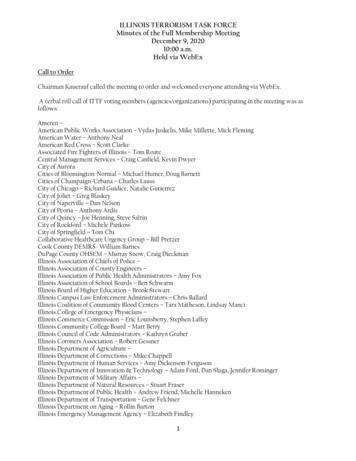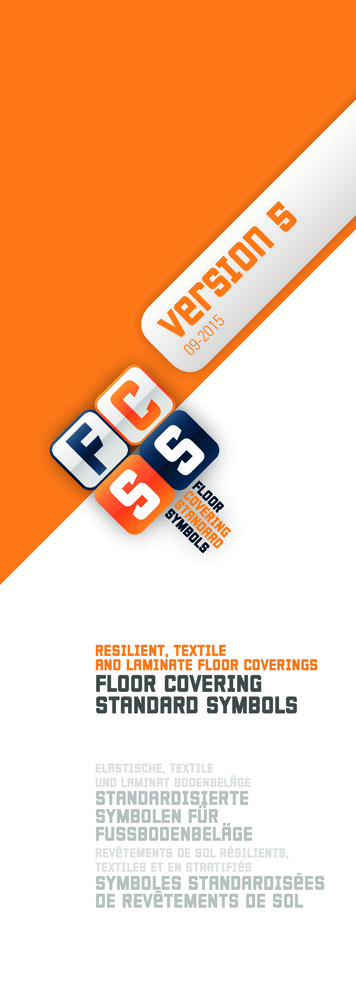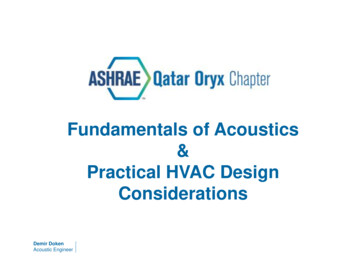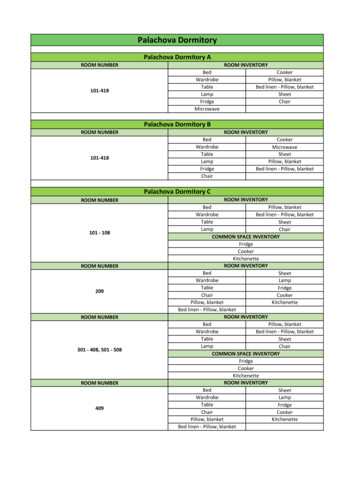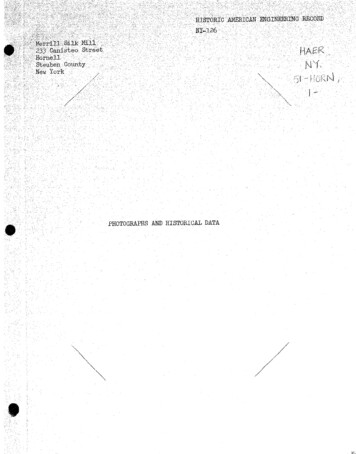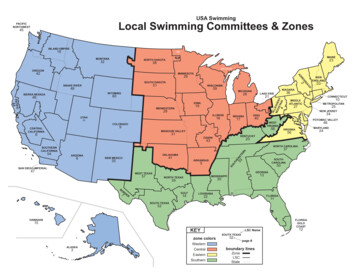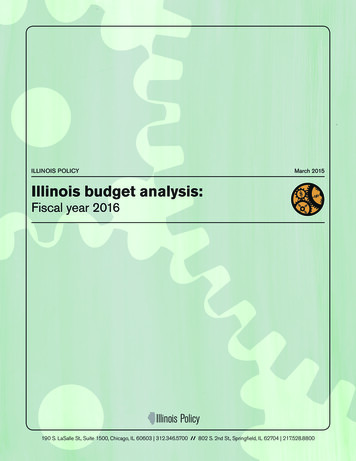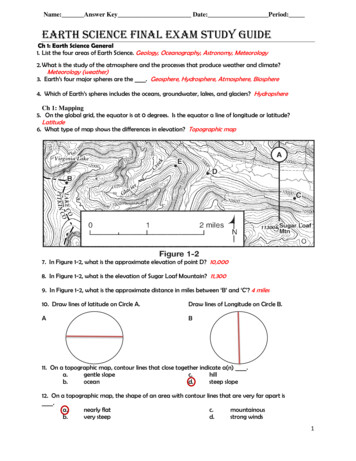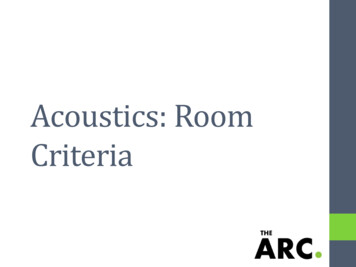
Transcription
Acoustics: RoomCriteria
Room criteria measures have been developedto evaluate existing background noise levels inrooms as well as specify required backgroundlevels for rooms to be constructed.Criteria are also often used for diagnostics offaulty equipment
A Weighted Sound Level:Devloped in early 30's for the measurement of noiseNoise Criteria (NC):Originally developed in late 50’s in response to growing HVACnoise problems in officesRoom Criteria (RC):Developed in mid 80’s in response to failings of NC methodRC Mark II:Developed in mid 90’s in response to failings of NC/RCNew NC:Developed in 2000’s in response to failings of NC/RC
Design vs Diagnostics Some criteria are more useful as a designcriteria and some are more useful fordiagnosing HVAC problemsASHRAE’s latest recommendations (toappear in a future handbook) are Use dBA and NC for design criteria (i.e. what youput in your design documents and the levels youwould design to meet)Use RC Mark II (and possibly RNC) fordiagnostics use when responding a noisecomplaint
A Weighted Level (dBA) The simplest noise criteria is measuring orspecifying a maximum A weighted level (dBA) This is highly limited as a diagnostic because allspectral information is eliminated during measurementand is not included in specificationThe difference between the A and C weighted levels(i.e. LC – LA) is related to the low frequency content.ANSI S12.2 states the spectrum is consideredimbalanced if LC – LA 13 dBA weighted sound level is probably the mostpopular design criteria S12.2 gives recommended A weighted levels in TableC.1
Table C.1 A-Weighted CriteriaOccupancyMax dBASmall auditoriums ( 500 seats)35-39Large auditoriums, theaters, and churches ( 500 seats)30-35TV and broadcast studios (close microphone pickup only)16-35Private ng Rooms39-48Schools:Lecture Halls and Classrooms (V 20000 ft3)35Lecture Halls and Classrooms (V 20000 ft3)40Open-plan Classrooms35
OccupancyMax dBAHotels/MotelsIndividual Rooms39-44Meeting/Banquet Rooms35-44OfficesExecutive35-44Small, Private44-48Large, with conference Tables and Small Conference Rooms39-44Large Conference Rooms35-39Open-plan Office Areas35-39Copier/Computer Rooms48-53Circulation Paths48-52
OccupancyMax dBAHospitals and ClinicsPrivate Rooms35-39Wards39-44Operating Rooms35-44Laboratories44-53Corridors44-53Movie Theaters39-48Small Churches39-44Courtrooms39-44Restaurants48-52Shops and Garages57-67
A-Weighted Sound LevelCalculating A weighted sound level for a given spectrumof sound levelsf (Hz)1631.5631252505001000200040008000LEQ (dB)79.371.256.448.240.136.131.1272421.1First adjust the given sound level by the A weightedadjustments given in Chp 3, Table 3.1 of LAAf (Hz)Adjust (A 9.4-26.2-16.1-8.6-3.201.21-1.1
A-Weighted Sound LevelAdd the A weighting adjustment to the givensound levels. Then use the following formula tocalculate the overall sound level.Reference the overall A weighted sound levelto the given tables to see if the sound level is satisfactory
Is dBA sufficient? Recent research (Ryherd, 2008) has shownthat simple A weighted levels correlate withworker perception and performance as wellas any other room criteriaFor this reason, A-weighted levels shouldprobably always be considered as a possiblecriteria for offices
NC Method The NC method was originally developed byLeo Beranek in the late 1950s and becamevery popular with architects and consultants A description of the original NC method isfound in LAA and most architectural acousticstextsIt is basically a comparison of spectra to a setof curves similar to equal loudness contours
NC Limitations NC method was limited in that the curvesused for evaluation/design did not extenddown to low frequencies Energy efficient HVAC systems that started beingdeveloped in the 1980s had significant lowfrequency sound levels that were not wellmeasured by NCNo check for unbalanced spectrum A room with a low noise level but a rumbly orhissy spectra can be just as bad as a noisy room.
New NC Method In 2008 an update to the NC method waspublished in ANSI S12.2-2008. The newstandard:Updates NC curves down to 16 HzRelates NC level directly to SIL levelIncludes checks for spectral imbalance andidentification of rumbly spectra that couldpossibly or likely be highly dissatisfying
New NC Curves1631.5631252505001000 8000 4000 1211463018840-2-4-4Hearing
NC Curves (ANSI S12.2-2008)10090sound pressure level -30NC-25NC-20NC-1560504030201001631.563125250500 1000 2000 4000 8000Octave Band Center Frequency [Hz]
New NC Procedure Get octave band sound levelsCompute the SIL (average of 250-2000 Hzoctave band levels)Plot spectra and see if it exceeds the NC-SILcurve anywhere. If not, the spectra gets anNC-(SIL) rating e.g. NC-(42) ratingIf the spectra exceeds the NC-(SIL) curveanywhere, the tangency method is used tofind NC value Select the NC-(XYZ) curve tangent to thespectrumCheck for spectral imbalance
Finding the NC RatingLp 521SIL (39 37 30 26)/4 33 dBSpectra is below NC-33 curve at allfrequencies so rate by the SILSpectra does not exceed NC-33 curve at lowfrequencies so there is little chance of seriousdissatisfaction
NC-33 By SIL Method10090sound pressure level -30NC-25NC-20NC-1560504030201001631.563125250500 1000 2000 4000 8000Octave Band Center Frequency [Hz]
Finding the NC RatingLp 1631.563125250500100020004000847568655850444337SIL (58 50 44 43)/4 49 dBSpectra is above NC-49 curve at 125 and 250 Hz souse tangency method125 Hz band is tangent to NC 51, so NC rating is NC51Spectra does exceed NC 49 curve at low frequenciesbut only by 2db so there is little chance of seriousdissatisfaction.
NC-51 By Tangency Method10090sound pressure level -30NC-25NC-20NC-1560504030201001631.563125250500 1000 2000 4000 8000Octave Band Center Frequency [Hz]
RC Mark II the Updated RC The RC system was developed in late 70’sand early 80’s by Warren Blazier for ASHRAEas a response to LF and HF problems withNC RC curves are considered spectrally balanced
RC Mark II Curves are similar to RC 5 dB/oct slope from 32-4000 Hz. Goes through RC level at 1 kHzFlat between 16 Hz and 32 Hz
RC Mark II Compute PSIL (avg of 500, 1k and 2k bands) to getthe RC reference curve for comparison and basic RClevel This is not SIL which is average from 250 to 2kFind average energy deviation between spectrumand RC reference curve in LF, MF and HF freqranges 0.1 L160.1 L 320.1 L 63L F 10 log 10 10 10/ 3 0.1 L1250.1 L 2500.1 L500M F 10 log 10 10 10/ 3 0.1 L10000.1 L 20000.1 L 4000H F 10 log 10 10 10/ 3
RC Mark IIQuality Assurance Index (QAI) is a quantitative measure of spectralimbalance that is included in the RC Mark IIThe QAI is the difference between the highest and lowest energyaverage spectral deviations (do not remove any negative signs) .If QAI 5 dB and L16(Hz) 65,L32 65 spectrum is designated neutral (N) andacceptable1.If QAI 5 dB, spectrum is designated LF, MF, or HF based on highestvalue of three For 5 QAI 10 dB spectrum is marginally acceptable For QAI 10 dB, spectrum is considered objectionableIf L16 65 or L32 65 spectrum is designated LFVbIf L16 75 or L32 75 spectrum is designated LFVa
RC Mark II What is the RC Mark II level of this spectrum?1631.5 63125 250 500 1k2K4K61.8 46.0 43.2 32.2 35.9 30.9 24.9 20.9 17.0
RC Mark IIf (Hz)163263125250500100020004000PSILLp (dB)68.661.84643.235.930.924.920.91726RC Mark IIRC 5117.65110.8460412.236-0.131-0.126-1.121-0.1161RC Rating RC 26HVb LF13.7 MF0.8 HF0.0QAI 13.7Max LFPSIL (30.9 24.9 20.9) 26LF 13.7 dBMF 0.8 dBHF 0 dBQAI (13.7-0) 13.7QAI 10 so spectrumwill be objectionableNote though that the LFregion extends into the highvibration region so thespectrum gets an HVb ratingand not just an LF ratingWe give this a rating ofRC-26 HVb
RC Mark II
References Archtiectural Acousitcs, Marshal Long, Chapter 3;(LAA)ANSI (2008). S12.2-2008: Criteria for EvaluatingRoom Noise (ANSI).ASHRAE (2007). 2007 ASHRAE Handbook: HVACApplications (ASHRAE).ANSI (2007). S12.2-2008: Procedure for theComputation of Loudness of Steady Sounds (ANSI).Prepared by Asfandyar Khan
Design vs Diagnostics Some criteria are more useful as a design criteria and some are more useful for diagnosing HVAC problems ASHRAE's latest recommendations (to appear in a future handbook) are Use dBA and NC for design criteria (i.e. what you put in your design documents and the levels you


